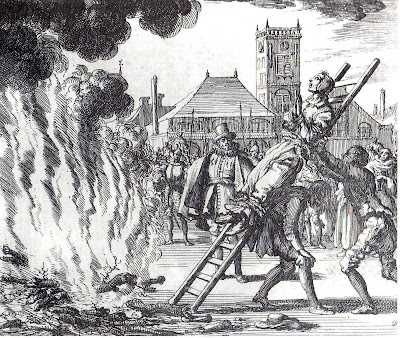Copyright 2020 by Gary L. Pullman
Assisted by demons and by
magic, witches could perform wonders. They often produced such
marvelous feats as changing women into men, although, it was said,
they were unable to do the opposite, transforming men into women,
because, as R. E. L. Masters observes in Eros and Evil: The Sexual
Psychopathology of Witchcraft,
“it is the method of nature to add rather than to take away”
(128). Apparently, although demons are, by nature, supernatural,
their powers are, nevertheless, constrained by the “methods” of
nature.
According to Masters,
witches frequently practiced
“ligature or the
production of impotence by magical means” (128-129). They used
various means. They might make a woman appear so repulsive that her
looks would quench her man's desire (129). (Think of the bathtub scene in The Shining.) More often, witches and
demons left men's libido unchanged, so that their victims could the
more greatly suffer, being unable to satisfy their lusts (130).
Demons
could also prevent intercourse by placing themselves between a
couple, thereby preventing any physical contact between the man and
the woman; could “freeze” lust; and could either cause the penis
to remain flaccid or to be unable to “perform” in its erect
state, “closing . . . the seminary ducts” (131).
Another
tactic available to demons and their witches was said to be the theft
of the male genitals themselves, either actually or by means of
inducing an illusion to this effect, although this method was hotly
debated (131-132). Masters declares that he has tried, with some
success, to reproduce the illusion through hypnosis: “I have so
managed that the subject could neither see nor feel his sex organ”
(132).
As
an alternative to blocking the seminal ducts, demons and witches
could desensitize the penile nerves, making the organ incapable of
assuming its erect state; could cause the semen “to congeal and
become hard as rock, so that it could not flow out of his urethra”;
shrink the organ “to a mere shriveled shred of flesh”; close the
vagina to prevent the introduction of the penis; or cause the penis
to retract into the man's abdomen (134).
One
of the chief means of inducing impotence in human males was the
“tying [of ] a knot in a cord . . . . and there were at least half
a hundred different knots, each inflicting a different degree or form
of impotence or frigidity,” permanent or temporary in its
duration(135).
The
same ingenuity of imagination that devised this array of magical
means for inducing impotence also suggested a variety of cures. God
Himself might intervene on behalf of the impotent man or the frigid
woman; magic spells might be reversed through “confession,”
remorse, making “the sign of the cross, humility, meditation, and a
pilgrimage to a holy and venerable shrine; or, by urinating through
her wedding ring, a wife might “undo the ligature” (136).
Witches
might also provide methods of preventing such curses. Using “pagan
amulets and charms” might do (that is, undo) the trick, and there
were several from which to choose, including “phallic symbols”
(an “upright knife and broomstick”); “bisexual symbols” (“a
horse's skull, a goblin's foot and a pentagram”); or “vulva
symbols” (“horseshoes and hag stones, or rocks with holes bored
through them” (136). “A love potion or philtre” might overcome
impotence or frigidity, or a witch might “restore” an impotent
man's manhood after he agreed to “copulate with her.”
There
was a limit to the powers of demons and witches to impose impotence
and frigidity, however, set by God Himself, according to Johann
Klein, and a reason for this limitation. As Masters summarizes the
divine motive: “God in all his divine love and mercy would never
allow such universal impotence or permit his beloved children to
perish by so odious a means” (137).
This
chapter, “Sexual magic,” of Masters's intriguing book shows, once
again, how inventive the human imagination can become when a woman is
threatened with or (monstrously, to be sure) subjected to torture
until she “confesses” what her tormentors want to hear and the
sexual repression of both the victims and the victimizers seek
release through any means possible.
Certainly,
no writer would or should subject him- or herself to such extremes,
but imagining
that the same fate could await one as thousands of women (and a
relatively few men) suffered at the hands of the Inquisition during
the Middle Ages could produce similarly imaginative and horrific
“accounts” of supernatural activity, whether related to human
sexuality, psychopathology, or some other sphere of human experience
as it is represented in fantastic fiction, including the horror
genre, which, unfortunately, is too often rife with “torture porn”
misogyny, and sadomasochism.
The
threat and fear of imminent death seems to have been a strong muse,
indeed, for both women accused of witchcraft and for Scheherazade,
the author of The One Thousand and One
Nights.










